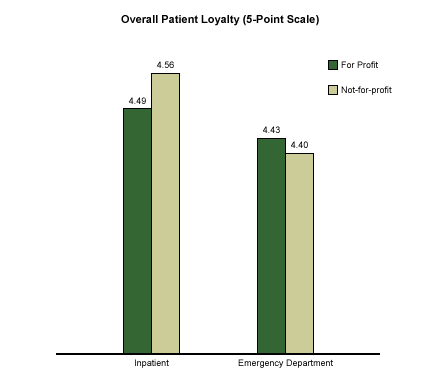Modern hospitals are funded by a variety of organization types -- charitable and religious groups, government agencies and for-profit companies. Although healing the sick has traditionally been viewed as a charitable occupation, healthcare organizations, particularly those that are for-profit, must be concerned with the bottom line in order to survive. Is the mission of healing at odds with the mission of profit?
Patient Satisfaction and Loyalty
To investigate the issue, Gallup examined its 2001database results for both patient satisfaction (which measures satisfaction with services provided) and patient loyalty (which measures likelihood to return) at for-profit and not-for-profit hospitals.


Inpatient
Gallup's 2001 database numbers, which include results from more than 240,000 inpatient interviews, reveal that inpatient satisfaction scores at for-profit and not-for-profit hospitals are identical (3.49 on a four-point scale). However, inpatient loyalty scores tend to be slightly higher at not-for-profit hospitals (4.56 on a five-point scale) than at for-profit hospitals (4.49 on a five-point scale). Because many of the not-for-profit hospitals measured have religious affiliations, religious loyalty among patients could be a factor in the difference.
Emergency Department
Emergency department (ED) results suggest an opposite tendency. Emergency department scores for both satisfaction and loyalty are slightly higher at for-profit hospitals than at not-for-profit hospitals.
The nation's emergency departments are in a state of crisis (see Related Items) caused by increased patient volume, short staffing, and inadequate, antiquated facilities and equipment. EDs at not-for-profit hospitals may be particularly vulnerable in this regard. They may have higher volumes because the uninsured are more likely to use them as a substitute for primary care. Furthermore, not-for-profit hospitals tend to have access to less capital, making facility and equipment upgrades and system improvements more difficult to achieve. For-profit hospitals are more likely to secure the capital they need, which could be a significant advantage to their emergency department operations.
Key Points
While some statistically significant differences between satisfaction and loyalty ratings at for-profit and not-for-profit hospitals can be identified, the differences are small in absolute terms. The slight differences that are seen are as likely to favor for-profit hospitals as they are not-for-profit facilities (e.g., for-profit ED scores are slightly higher). Thus, the evidence does not support the hypothesis that the mission of healing is at odds with the mission of making a profit.
Furthermore, Gallup research has shown large variance between satisfaction and loyalty scores for hospitals within the for-profit and not-for-profit sectors. Are for-profit hospitals different from not-for-profits? The most likely answer is that it depends on the hospital.